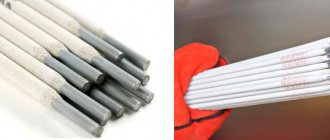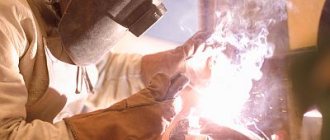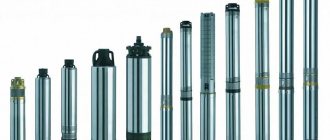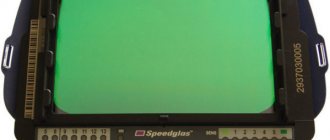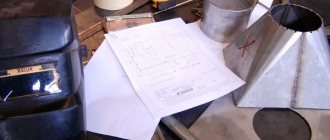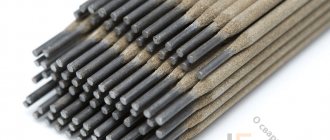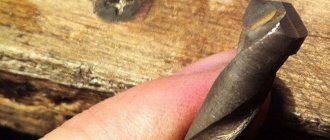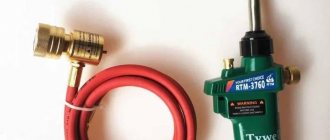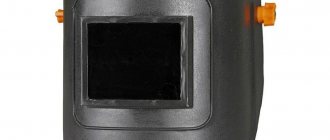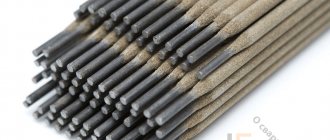- Home page
- •
- Articles on welding
- •
- Welding helmets: types, characteristics, features of choice
In this article we will look at the features and types of welding helmets, as well as what to look for when choosing
The electric arc emits bright light and ultraviolet rays that can burn the cornea of the eye. To protect your eyesight and clearly see the processes occurring in the weld pool, you need a high-quality welding mask. What they are, how they differ and what to look for when choosing, we will consider in this article.
In this article:
Welding masks are made from fiberboard and fire-resistant plastic. The first option is easier and cheaper. But the cardboard gradually loses its shape, the helmet warps, and may come apart at the corners (assembled with brackets). Cardboard is able to absorb moisture if the personal protective equipment is stored in a room with high humidity of 70-80%.
Plastic masks differ in material thickness and composition, which affects weight. Cheap models may melt or stick if accidentally placed on a hot surface (such as a newly welded seam). Expensive plastic masks are completely non-flammable and can withstand high temperatures. They are resistant to moisture and do not deform during use. For infrequent use, you can save money and buy a cardboard shield. If you plan to cook regularly, choose a plastic option.
View window size
The size of the viewing window for welding helmets can be minimal - 89x39 cm or maximum 110x90 cm. There are many intermediate options: 100x60, 90x60, 110x60, etc. If you have to weld small parts only in the lower position, any viewing window will do.
It is more convenient to carry out work on large structures that require numerous seams in masks with good visibility. Then you won’t have to twist your neck, but just turn your eyes slightly to see the joint clearly. Such masks are useful for welding pipes close to a wall, floor, and making ceiling seams. In this case, pay attention specifically to the size of the light filter, and not the outer glass, since the outer screen can be much larger than the viewing window itself.
Filter type
The filter, which protects the eyes from harmful radiation, can be permanently darkened for conventional welding helmets or automatic. In the first case, black glasses are used, each of which is assigned a number indicating the strength of the darkening. Almost nothing is visible through them until the welding arc is lit. This makes it difficult for the electrode to accurately hit the joint; you can miss and leave marks nearby on the front side, which will then have to be cleaned up. After welding, the quality of the seam is not visible through the light filter and the helmet is raised to inspect the connection.
Automatic darkening is implemented in chameleon masks. They use liquid crystals and sensors that respond to an electric arc flash. In the cleared state, the crystals are located across the cross section of the glass and provide acceptable visibility to the welder. Using the mask, you can accurately point the electrode or torch at the joint, examine the quality of the seam, assemble simple structures and immediately proceed to tack welding.
Reading characteristics
Welding helmets have a designation of their indicators, which are included in the documentation or on the body. Knowing how to read them, you can choose the appropriate model. Chameleon markings are indicated by numbers separated by a slash. It looks like this: 1/1/2/2. You need to pay attention to:
- The first number indicates the distortion indicator of the optical lens. The smaller it is, the more realistic the image through the viewing window will be.
- The second number refers to the light scattering index. It is important to pay attention to this for those who have to weld thin seams and small parts. The lower the number, the better the clarity of the lens and the better the visual inspection.
- The third number denotes homogeneity - the quality of shading that extends to the entire surface, including the stripes at the bottom and top. The lower the value, the better.
- Darkness level. The fourth digit shows the class of the shield. 1 is high, 2 is low.
You also need to pay attention to the dimming scale. DIN can vary from 5 to 15, depending on the lightness of the filter. Masks with 13-15 DIN will be good indicators. There are also three-stage Chameleons, which, between the light and dark modes, include an intermediate - medium, protecting the eyes from the light of the cooling metal.
The modern market offers a wide variety of welding masks. Understanding their purpose, design features, and compliance with operating conditions, you can choose the right option.
What to look for when choosing
The degree of darkness and its change
The degree of darkening of the filter is selected based on the illumination of the workplace and the strength of the welding current.
The more light and higher the current, the darker the glass should be. For masks with conventional light filters, when working outdoors or welding with a current of 300-400 A, glass number 5 is required. Indoors, it is changed to number 4. Welding at low currents of 50-120 A requires filter number 3. In chameleons, the degree of darkness is indicated in DIN. Argon, semi-automatic and manual welding with coated electrodes requires the following values:
- at currents of 40-80 A - 10-11 DIN;
- 100-150 A - 12 DIN;
- 200-300 A - 13 DIN;
- 400 A - 14 DIN;
- 500 A - 15 DIN.
Grinding mode and mask design options
If you not only need to weld, but also process metal (cutting, grinding edges, sanding the top layer of a seam, etc.), buy a mask with a grinding mode. Such PPE is equipped with a switch with “welding/grinding” positions. In the latter, the filter stops responding to sparks from the angle grinder, always remaining in a cleared state. Through it, the cutting line is clearly visible and the eyes are protected from scale. Masks with a grinding mode save time by not requiring you to regularly replace your helmet with goggles. This is very useful when working independently, when you need to weld a joint, make a cut and weld again.
Another option for grinding is masks with a convertible top, such as PREMIER Favorit SOMZ or ESAB ECO-ARC II 110*90. They have a filter with a constant degree of darkening, but it is located in a cassette that folds up. Then the welder’s eyes remain protected by ordinary glass, through which it is convenient to look while cutting or beating slag.
Number of sensors
Sensors or light sensors are responsible for detecting the electric arc flash and turning the crystals around. Budget masks usually have two sensors located under or above the viewing window. This is enough for correct operation when welding small parts in the lower or vertical positions.
If you have to weld pipes or large parts, then the sensors can be covered with the product itself, after which the crystals are rotated to make the filter clear, although the arc is still burning. Such work will lead to “catching bunnies” and retinal burns. In this case, buy a welding helmet with 4 sensors. Even if some of them are closed, the dimming will work adequately. There are even models with 5 sensors, but their price is much higher.
Connection to turbo unit
Harmful fumes and smoke when welding outdoors are blown by the wind, and indoors - due to exhaust ventilation. When you have to cook inside a large boiler, container, or other closed structure, buy a mask with a turbo unit. She has a sealed helmet, a flexible tube and a belt unit. It has a multi-stage filtration system and forced supply of purified air into the welder’s mask. This allows you to safely carry out work in specific conditions. When the battery of the ventilation unit is close to discharge, the helmet beeps, warning in time that it is time to call it a day and leave.
general information
A welding helmet is a protective item for welding work that protects the welder from the negative consequences of the welding process. The mask protects not only the eyes, but also the neck, respiratory tract, and face. Failure to use a mask may result in complete or partial loss of vision. Also, a welding helmet is often referred to simply as a “welding helmet” because it covers not only the face, but also the head.
Most welding helmets have a viewing hole that allows the welder to observe the welding process. The hole is covered with tinted glass or plastic. Sometimes special filters that react to light are used.
Welding helmet selection options
Location of controls
Adjustment of response sensitivity and degree of dimming is carried out by two “knobs” that interact with the electronic board. They can be located both inside the helmet and outside. In the first case, you will need to remove the mask, take off your gloves (the wheels inside are very small) and make adjustments. This is acceptable when adjustments are not needed often. In the second case, you can change the sensitivity and darkening strength directly while welding, which is convenient when frequently switching between welding thin and thick metals.
Power type
Chameleon masks are powered during operation by absorbing light from an electric arc by a solar panel. While welding is not in progress, a battery or accumulator is used for starting energy. The batteries will have to be changed periodically, but the battery will last longer.
Optical class of lens
The characteristic is indicated by four numbers, written separated by a slash. They indicate the following properties:
- Image accuracy.
- Level of light dispersion.
- Uniformity of light transmission.
- Effect of viewing angle on light transmission.
The number 1 indicates the first, i.e. top class in every category. For example: 1/1/1/1 is a lens with the best parameters for clarity, light transmission and uniformity. In a mask with a 1/2/1/2 lens, the picture will not be as clear, the corners may be darkened.
When welding channels and other large structures, high image detail is not needed. It is enough to clearly see the edges of the joint and the turns of the seam line. Therefore, any lens will do here. But when argon welding of thin metals 0.6-1.0 mm at low currents there is little light from the arc, so you need high picture quality. In this case, buy a helmet with a 1/1/1/1 lens.
Head design
There are three-rack and four-rack options. The latter fit more securely on the head and have a greater number of adjustments. Choose a four-bar headband mount if you often move around wearing a mask, cook while leaning over the railing, etc.
Recommendations for selection
When you are about to buy a welding helmet, you should first think through the desired functions that should be built into it. However, there are criteria by which it is much easier to select a mask:
- Manufacturer. Trusted manufacturers of welding protective equipment always provide quality certificates for the products they sell. Accordingly, Chinese-made products have no certificates or are counterfeit.
- Case material. GOST 12.4.035-78 has been compiled for the characteristics of the material from which welding helmets should be produced. GOST states that for the manufacture of welding masks it is necessary to use materials with high heat resistance and electrical insulation. Some types of plastic, nylon, fiberboard, polypropylene, as well as fairly light alloys, such as Kevlar (quite expensive), have similar properties.
- Fastening material. The weight of the helmet depends on the material from which the shell is made, as well as on the material of the fastenings. Plastic is the most common, as it is lightweight and quite inexpensive. The mass is also affected by the presence of various features in the form of batteries, a power supply and other “bells and whistles”.
- Metal splash filter. Recently, this function has become so popular that almost no copy can do without it.
- General functionality. Ease of fastening, tight fit to the face, accessibility and clarity of adjustments. It is advisable to check all this before paying for the purchase.
- Price. Based on all the requirements, the price of welding masks varies from 50 rubles for a fiber shield for an amateur to 40 thousand rubles for a state-of-the-art mask.
Working principle of a welding helmet
Response time
Affects how quickly the crystals unfold to protect the eyes from the flash. Visually, everything happens instantly, but in fact, in household masks this takes 1/10,000 of a second, and in professional masks it takes 1/20,000 or 1/30,000 of a second. When working during the day, your eyes get more tired wearing a household mask. But when welding is needed for a couple of hours a week, there is no noticeable difference.
Operating temperature
Self-darkening PPE has one significant drawback - it does not work well in the cold. It's all about liquid crystals, and liquids tend to freeze at subzero temperatures. But there are differences here too: some chameleon masks can only be used at -5º C, while others can withstand up to -10º C. At lower temperatures, the screen begins to “blink” and response delays occur. If you want to cook chameleon in an unheated room in winter, pay attention to this characteristic.
If you regularly work outside in frosts of -15º C and below, a mask with regular dark glass is more suitable. Negative temperatures do not affect it in any way.
Mask weight
The weight of a welding helmet ranges from 400 to 700 grams. With rare use, this is imperceptible, but with everyday work and nodding to lower the helmet, the neck quickly gets tired of the heavy shields. It is wise to choose a lighter mask - optimally up to 500 g. The OPTREL brand has a Weldcap welding cap that weighs 400 g and is suitable for working in the lower position.
FULL COLOR technology
The manufacturer BARSVELD has a number of shields with FULL COLOR technology. It ensures the transmission of natural colors of materials during welding. This is useful when working with non-ferrous metals (aluminum, copper) in order to clearly see the edges, weld pool, and degree of fusion of materials.
Types of structures
Long gone are the days when specialists used homemade masks made from a combination of cardboard and sunglasses for welding work. Since that time, the design and properties of this protective element have undergone significant changes. Now, in addition to the eyes, you can protect your entire head from external influences.
Based on the type of design, there are two types of filters:
- Active. In this case, the darkening of the filter occurs in the first seconds after the flash of the welding arc.
- Passive. This filter is recognizable by the fact that the darkening level remains constant regardless of the light level.
In addition to the level of darkness, face protection elements are as follows:
- The glasses are very convenient to use, as they have fastening straps, free your hands, and do not restrict head movement. But not everyone uses them and not always, mainly for work in hard-to-reach places. Because their protection is aimed at the face, namely the eyes, glasses are equated to masks. The light filter on welding glasses is most often used active.
- The shield is a simple glass structure with a passive light filter and a handle for easy holding. This design is not always convenient, as it eliminates the possibility of working with two hands, which often reduces the final result.
- Welding helmet - this type is especially common among welders, due to its ease of use and the largest area of head protection. In turn, helmets and masks come with both active and passive light filters, and the fastenings leave your hands free and allow you to pay more attention to the welding process.
Each specialist chooses the type of welding mask that suits his parameters. However, professional welders always have masks of various types and with different levels of darkness in their arsenal. The most popular among this element of equipment are masks with an active light filter - a chameleon.
TOP best models
Thanks to the ability of almost every person to go online and share their impressions of purchasing any product, experts compile special ratings on their websites that reflect the average price, advantages and disadvantages. We will list the majority of models from Polish, American, ours and other manufacturers from several ratings (they vary from all sources) and tell you how a particular unit distinguished itself and made it to the TOP.
Let's start with inexpensive models:
- Brima HA-1005. Inexpensive ordinary welder's mask. The protective lens can be raised and lowered, the body is made of impact-resistant heat-resistant polypropylene, the weight is 800 g. It costs around 250 rubles. It is better to assemble according to the instructions (included in the kit).
- RESANTA MS-4 65\34. This unit from a well-known company has a Chameleon system, the darkening level is 4-11 DIN. Dimming speed – 0.0001 s, two solar batteries, weight – 430 grams, price is around 1200 rubles. It comes without sensitivity adjustment, if with a wheel, then it is better to choose MS 1 or MS 3, more expensive - about 2200.
- FUBAG Optima 11 – budget version, 3 DIN. The speed is 0.25-0.6 s, more for domestic purposes, since there is not even 0.003 s. 1200 price. Solar battery, two batteries.
- Foxweld Corundum 5895 is a good unit, inexpensive, with a minimum of useful functions, but it is powered by both a battery and a battery. Foxveld is a lightweight, durable mask, 9-13 DIN, the speed is quite good - 0.1 ms.
- Wester WH1 is a decent unit, a very interesting model for 9-13 din, weighs only 460 g. It has Chameleon functions, but there is no grinding mode. What’s more surprising is the price – around 200 rubles. Response speed – 40 µs. The cost is alarming, however, the mask was included in the ranking of the best for a reason.
For professionals, the following units were well noted:
- Fubag Optima 9-13. 9-13 DIN, many useful modes, from grinding to auto-darkening. Everything is adjustable, weight is only 500 grams. The price is around 2-3 thousand rubles. Found in almost any online store.
- 3M Speedglas 9100 is not only a model, there are many different modifications, for example, SPIDGLAS 3M 9100 XX is in first place in the ranking of the best pro class masks. There is also the Speedglas 9100 MP Air - a whole helmet with forced air supply, controllers, adjustments - everything can be customized, however, it is expensive (the cost depends on the version). Air cylinders can be placed in a backpack.
- ESAB WARRIOR TECH - costs about 8000, many useful functions. A unit for true professionals. Warrior Tech 9-13 is also, as noted in reviews, a very practical and convenient model with the Chameleon system.
- ROSOMZ HH12 Crystaline Standard Favorite. A model with good performance, all the necessary adjustments, it can withstand severe temperature changes. Despite the high price (7300 on average) and the lack of some modes, the mask was rated for its effectiveness of protection during argon and electric welding and protects well from scale.
- Aurora Sun-9 Max Expert – attracts both appearance and functionality. 4 sensors, LCD filter, degree of transparency from 3 to 13 DIN. The line is presented by “sun” and number: SUN-7, SUN-8 and so on. Disadvantage: non-replaceable batteries. Price around 5000 rub. There is also Aurora a 998f black cosmo from this manufacturer, which is also included in the rating of the best products for professionals with a wide range of functions.
- Svarog 4001 F is the choice of many welders. Mask with adjustable transparency 3-13 and degree of darkness 4 DIN. 4 optical sensors, a channel for air supply, even a battery charge indicator - everything a master needs! There is a solar battery.
Model ESAB G-30 for 13 DIN. It also appears in some ratings; there is an opinion that it has earned a place in the TOP thanks to its comfortable internal coating.
In general, the best units are also the masks: Falon Tech, Jackson, Lincoln Electric, Tekmen, PIT, Kempi, Optrel, Redbo, Patriot (patriot 350D and Patriot 600S stand out - quite comfortable), Leopard, Predator, Minion, Kedr, Zeus, Bison, Sentinel (Sentinel A50 has many good reviews). For example, welders often buy the BARS MS 307 model from Bars; the Kemppi Beta 90 mask has proven itself well. Kemppi Beta 90 (correctly in English) is found in many online stores, the price corresponds to the quality, incl. in accordance with GOST.
In the photo, Kemppi Alpha has a durable body.
Professionals often use masks from Fronius; the Fronius Vizor 3000 Standard unit has proven itself.
The ratings are constantly updated, so we have listed the best manufacturers and models that have proven themselves in practice. As you can see, most welder masks are good units, since human safety depends on them; it is important to choose the right one for yourself and the nature of the work.
How much does a welding mask cost?
- The simplest models, made of plastic or pressed cardboard, cost about 300-500 rubles;
- More advanced chameleon masks are more expensive: the price tag for them starts from 1000 rubles for basic devices and ends at about 4000-5000 for models that allow you to work with thin metals;
- The most expensive ones are masks for welding with forced ventilation - their cost can reach 100 thousand rubles or more.
In the following articles, our experts tell you how to choose a saw blade, the secrets of choosing a welding machine and the features of choosing a laser level.
content
- The best manufacturers of welding masks
- Operating principle and design of a welding helmet
- Types of welding masks
- Welding helmet selection options
- Which welding mask to choose - expert recommendations
- How much does a welding mask cost?
The best manufacturers of welding masks - which company to choose
Currently, there are a huge number of welding helmet models on the market from a variety of manufacturers. When choosing such a tool, you should give preference to products from well-known, reputable manufacturers of construction equipment, as well as those companies that are specifically engaged in the production of professional welding equipment. In general, we can recommend products from the following manufacturers for purchase:
- Patriot
- Force
- Fubag
- Bison
Understanding and choosing the best option is not difficult. All you need is to carefully study the characteristics of a particular model and determine whether it suits your operating conditions or not.
Operating principle and design of a welding helmet
A welding helmet is a special protective device designed to perform a number of protective functions:
- Protecting the cornea from flashes of bright light and ultraviolet rays, which, with constant exposure, can lead to deterioration and even loss of vision;
- Eye protection from scales formed during metal welding in the form of small slag particles;
- Protection of the eyes and respiratory system from caustic and toxic gases released during the welding process;
- Thanks to the fixation on the head, a correctly selected mask frees up the welder’s second hand, which makes the welding process much more convenient and handy;
The design of any, even the simplest, welding mask includes two main elements:
- A special casing that covers the welder’s face, head and part of the neck while working;
- A special viewing window with an installed light filter that protects against ultraviolet radiation, bright flashes and rebound scales. Its design is such that the welder has the opportunity to observe the process - he sees the seam itself, as well as the contours of the surfaces being welded;
- Depending on the design of a particular model, the manufacturer can install many additional functions, the most significant of which are:
- A control element that regulates the degree of darkening of the filter;
- Anatomical fixing element for mounting on the head;
- A special panel designed to charge the built-in batteries from the flash during welding;
Which welding mask to choose - expert recommendations
- To perform one-time welding work at the dacha or in the garage, there is no need to buy an expensive mask. The classic model, made of cardboard or plastic and having a regular glass filter with a viewing window of about 90x40 mm, is an excellent option. If we are talking about working with water or sewer pipes, preference should be given to a similar model, but with a viewing window, the length of which will be 100-110 mm and the height 45-50 mm;
- When working with stainless steel, preference should be given to the “chameleon”, the “distortion” parameter of which will be “1”, and the “light scattering” - “2”. In the case where you have to work with thin metal, the light scattering parameter should be set to o;
- If you have to work in difficult or life-threatening conditions, the best option would be a mask equipped with additional ventilation. Its parameters should be selected based on specific operating conditions and type of metal;
